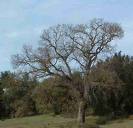Roble Tree Information
Images of Roble:






Roble grows in the following 1 states and provinces:
CaliforniaInformation about Roble:
The Quercus Lobata is commonly known as the California White Oak, Roble, Valley Oak, Valley White Oak, Water Oak, Weeping Oak as well as White Oak.
The currently accepted scientific name of valley oak is Quercus lobata Nee. in the subgenus Quercus or white oak . Recognized varieties are as follows : Q. lobata var. lobata Q. lobata var. agillara Jeps. Q. lobata var. insperata Jeps. Q. lobata var. turbinata Jeps. Q. lobata var. walteri Jeps. Valley oak hybridizes with the following species: x Q. douglasii (blue oak): Q. Xjolonensis Sargent x Q. turbinella ssp. californica (desert scrub oak): Q. Xmunzii Tucker x Q. dumosa (California scrub oak): Q. Xtowneii Palmer x Q. engelmannii (Engelmann oak] x Q. garryana (Oregon white oak) MacDonald oak (Q. macdonalii), found on the Channel Islands, is recognized by some authorities as a distinct species resulting from hybridization between valley and California scrub oak .Valley oak is endemic to California. It is distributed from Shasta County south through the Central Valley and lower-elevation foothills and valleys of the Sierra Nevada and Coast Ranges to Los Angeles County . It also occurs on Santa Cruz and Santa Catalina Islands .This species dominates two plant communities: the valley oak woodland and the valley oak riparian forest. It is often the only tree in valley oak woodland, which are composed of grassy savannas with large, widely spaced oaks. The valley oak woodland and the annual grassland are closely associated, and together form a mosiac over portions of California's low-elevation rangeland . Historically, the associated grassland was probably dominated by perennial bunchgrasses . Valley oak woodland, once extensive, has largely been cleared for farmland and now occurs in scattered remnant patches. Isolated trees are sometimes found in cultivated fields . Valley oak riparian forest occurs on levees and the highest parts of floodplains . Canopies are open to densely closed; shrub cover may be as great as 70 percent . Historically, these forests extended 0.6 to 5.0 miles (1-8 km) on each side of major rivers . Valley oak riparian forest merges with Fremont cottonwood (Populus fremontii) riparian forest near waterways and with valley oak woodland on upland sites . In foothill oak (Quercus spp.) woodlands, the valley oak phase merges with the California black oak (Quercus kelloggii), coast live oak (Q. agrifolia), or interior live oak (Q. wislizenii) phases . Valley oak is an indicator of rich, deep alluvial soils that comprise some of the most fertile farmland in the world . Publications listing valley oak as a dominant or codominant species in habitat typings are as follows: A classification system for California's hardwood rangelands . Blue oak communities in California . Association types in the North Coast Ranges of California . Riparian vegetation and flora of the Sacramento Valley . Oak woodland . Vegetation and floristics of Pinnacles National Monument . Terrestrial natural communities of California .Some of the information provided here is attributed to:Howard, Janet L. 1992. Quercus lobata. In: Fire Effects Information System, [Online]. U.S. Department of Agriculture, Forest Service, Rocky Mountain Research Station, Fire Sciences Laboratory (Producer). , available at the USDA Fire Effects Information System (FEIS) website